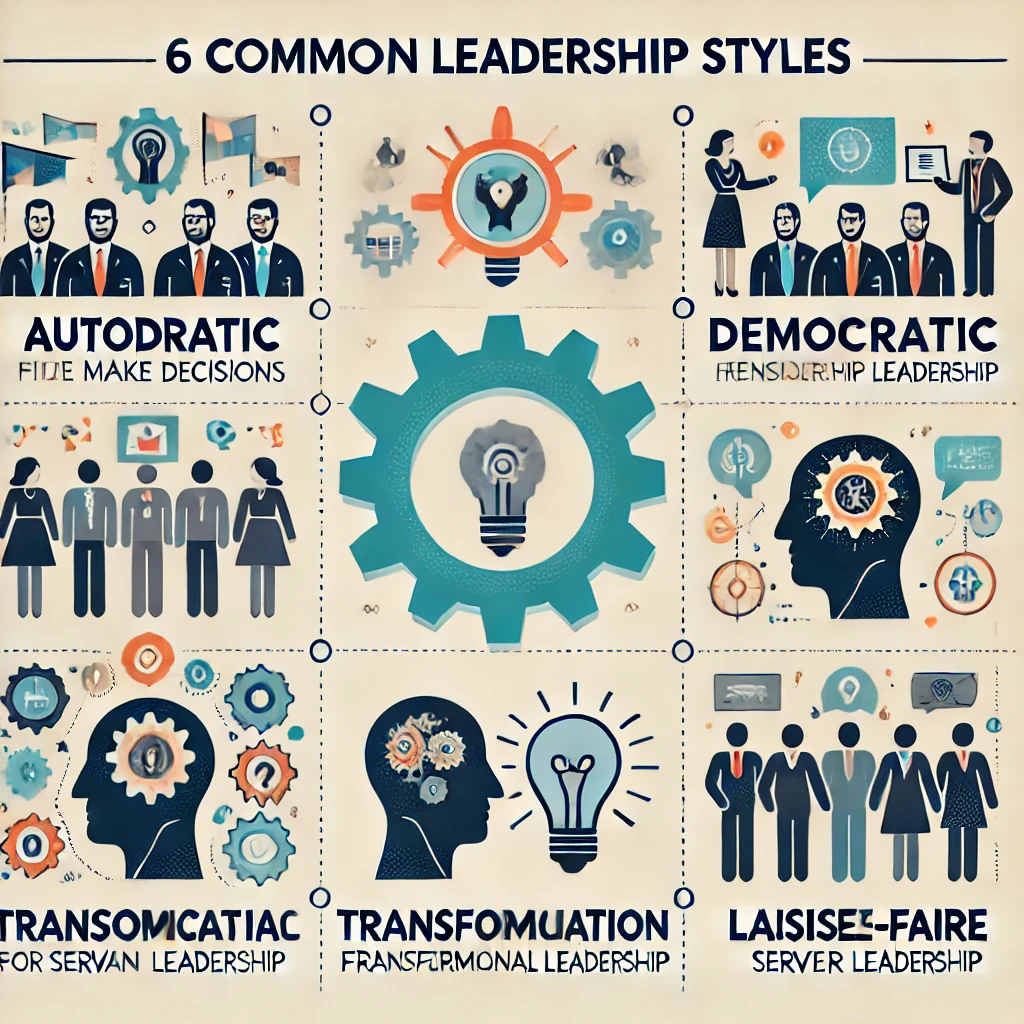6 Common Leadership Styles — and How to Decide Which to Use When
In the dynamic world of leadership, the most effective leaders are those who understand that no single approach fits every situation. Instead, they adapt their leadership style to suit the needs of their team, the organizational environment, and the challenges at hand. This flexibility allows leaders to inspire, motivate, and guide their teams to achieve extraordinary results.

In this article, we’ll dive into six common leadership styles, real-world examples of each, and how to decide when to use them for the greatest impact. By the end, you’ll have the insights you need to assess your own leadership approach and unlock your team’s potential.
1. Autocratic Leadership
Definition: Autocratic leaders hold tight control over decisions and typically provide clear instructions with little input from team members. In this style, the leader holds all the authority.

When to Use:
- In a crisis: Autocratic leadership works well when decisions need to be made quickly, such as during a company emergency or major deadline.
- Example: During SpaceX rocket launches, Elon Musk is known to take an autocratic approach to ensure critical decisions are made rapidly and without confusion.
- For inexperienced teams: If your team lacks the expertise to make sound decisions, this style can ensure clear guidance. Potential Drawbacks: While autocratic leadership can lead to fast decision-making, it may alienate team members if overused, stifling creativity and limiting team development.

2. Democratic Leadership
Definition: Democratic leaders involve team members in the decision-making process, ensuring that everyone’s voice is heard before making a final call.
When to Use:
- For complex problems: When multiple perspectives and expertise are required, such as in creative industries.
- Example: At Google, decisions are often made democratically by encouraging collaboration and feedback from diverse teams, fostering innovation and inclusivity.
- To boost team engagement: If team morale is low, involving members in the decision-making process can help reignite their passion. Potential Drawbacks: Seeking consensus can slow decision-making, especially if there are conflicting opinions. In urgent situations, this may delay necessary action.
3. Transformational Leadership
Definition: Transformational leaders inspire and motivate their teams to exceed their usual performance by promoting a shared vision and encouraging innovation.
When to Use:
- During periods of change: Ideal for times of organizational transformation, growth, or innovation.
- Example: Satya Nadella, CEO of Microsoft, is known for his transformational leadership, driving a culture of innovation and collaboration, which revitalized the company’s trajectory.

- With a motivated team: If your team is already driven and goal-oriented, a transformational leader can help them reach even greater heights by inspiring a sense of purpose. Potential Drawbacks: Overusing this style can lead to burnout, as constant motivation without sufficient breaks or rewards may overwhelm your team.
4. Transactional Leadership
Definition: Transactional leaders focus on rewards and punishments to motivate their team members, ensuring clear objectives and outcomes.
When to Use:
- For structured environments: When roles are clearly defined and objectives are straightforward, such as in sales-driven industries.
- Example: In a sales team, a transactional leader might offer bonuses based on reaching specific targets, creating a clear incentive for performance.

- For short-term goals: Transactional leadership works best when managing projects with clear deadlines and expectations. Potential Drawbacks: While effective for achieving specific outcomes, this style may suppress creativity, as team members might only focus on meeting targets rather than thinking outside the box.
5. Laissez-Faire Leadership
Definition: Laissez-faire leaders take a hands-off approach, allowing team members to make their own decisions and manage their work independently.
When to Use:
- With highly skilled teams: If you have experts in their fields who don’t require much supervision, laissez-faire leadership gives them the freedom to innovate.
- Example: Warren Buffett famously trusts the leaders of Berkshire Hathaway’s companies, taking a laissez-faire approach to allow them autonomy in decision-making.

- In creative industries: When you want to encourage innovation and allow for out-of-the-box thinking, this leadership style can be empowering. Potential Drawbacks: Without proper oversight, teams can lack direction, leading to confusion or subpar performance, especially if they need more guidance.
6. Servant Leadership
Definition: Servant leaders prioritize the well-being and development of their team, often leading by example and focusing on the success of others first.
When to Use:
- To build trust and loyalty: This style fosters a strong sense of trust and respect among teams, which can be invaluable in service-based industries.
- Example: Howard Schultz, the former CEO of Starbucks, is often seen as a servant leader, focusing on employee well-being and creating a positive work culture.

- To develop future leaders: Servant leadership works well when you want to nurture the next generation of leaders within your organization. Potential Drawbacks: If not balanced, servant leadership can slow decision-making or lead to the leader being taken advantage of if they focus too much on pleasing everyone.
How to Decide Which Leadership Style to Use
The most effective leaders know how to assess the situation and choose the right style. Here’s a quick guide on how to decide:
- Assess Team Dynamics: Understand your team’s experience, skills, and motivation. Autocratic leadership may be necessary for inexperienced teams, while laissez-faire leadership can work for skilled, autonomous groups.
- Evaluate the Situation: In times of crisis, quick decisions through autocratic leadership may be essential. For long-term innovation, transformational leadership is often the most effective.
- Consider Organizational Culture: Your company’s values and culture also dictate which leadership style fits best. A startup may thrive under transformational leadership, while a more hierarchical organization may require a transactional or autocratic approach.
- Blend Styles for Flexibility: Great leaders aren’t restricted to one style. They adapt and blend styles to meet the changing needs of their teams and the challenges they face. For example, combining democratic leadership with transformational approaches can foster both collaboration and innovation.
Expert Opinions on Leadership
Leadership experts emphasize the importance of adaptability. Simon Sinek, renowned for his insights into leadership, believes that successful leaders put their people first, aligning closely with the principles of servant leadership. As he famously said, “Leadership is not about being in charge. It’s about taking care of those in your charge.”
Similarly, John C. Maxwell, a prominent leadership coach, asserts that “a leader is one who knows the way, goes the way, and shows the way.” This echoes the idea that effective leaders lead by example, aligning with both transformational and servant leadership styles.
Call to Action: Find Your Leadership Style
Now that you’ve explored these six leadership styles, it’s time to assess your own. What kind of leader are you? Do you tend to inspire through transformational leadership or take control in critical moments with an autocratic approach?
Take action today by reflecting on your leadership style and how you can adapt it to different situations. Consider taking a leadership style quiz to better understand your strengths and areas for growth. For further reading, check out books like “Leaders Eat Last” by Simon Sinek or “The 21 Irrefutable Laws of Leadership” by John C. Maxwell.
By understanding and adapting your approach, you can become a more effective, empathetic, and results-driven leader.
for more visit






